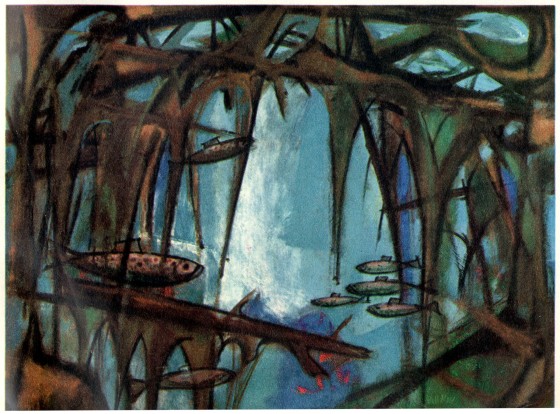Did you know that Ford Motor Company supported and encouraged the artistic activities of its employees, sponsored traveling art exhibitions, and published contemporary American art in its company magazines? I had no idea until I found a couple of copies of Ford Times magazine and a Lincoln-Mercury Times in one of our collections.

“Fish,” Big Spring, Michigan. Lincoln-Mercury Times, May-June 1956. Painting by Bill Moss. Moss was a graduate of the Academy of Art and painted over 300 works for Ford Times from 1949-1958.
Much of the auto company’s support and use of artworks began under Arthur Townsend Lougee, who served as the Executive Editor and Art Director of Ford Times magazine, as well as the Lincoln-Mercury Times, from 1946-1961. During his tenure, Lougee commissioned thousands of articles on America and Americana, which were illustrated with watercolors by regional Ford artists who, for the most part, painted local motifs. Ford’s policy was to leave the subject matter up to the discretion of the artist.

“Lake Superior’s Eastern Shore.” Lincoln-Mercury Times, May-June 1956. Painting by Robert Bannister
A small company magazine at 4 x 6 inches, each issue of the monthly Ford Times consisted of several stories about vacation destination spots and those of historical interest, as well as promotional information about contemporary Ford products. Watercolor paintings first appeared as cover art in the June 1946 issue, and on the interior in September 1947.

“Fruita,” Bryce Canyon National Park. Ford Times, Sep 1959. Painting by V. Douglas Snow.
Lougee also assembled the Ford Times Collection of American Art, a collection of over 7,000 of the paintings commissioned for the Ford publications. Nearly 700 American painters were represented in the collection. The Ford Times art exhibition program was established in 1954 and made available to schools and universities, libraries, and art organizations across the country. Exhibitions included American Byways (1953), Artists and Fishermen (1955), Faculty Artists (1962), Variety No. 8 (1962), and Travel in Mexico (1969). Under the auspices of the United States Information Agency, international exhibitions traveled to countries in Asia, Africa, Europe, and the Middle East as a way of promoting good will and friendship among nations.

Lincoln-Mercury Times, May-June 1956
Thanks to the collection of Jack Keijo Steele, a Cranbrook Academy of Art alum, clay modeler in the Ford Styling Office, and lifelong painter, we are able to tell this interesting story of Ford’s contributions to art in this country.
– Leslie S. Edwards, Head Archivist









